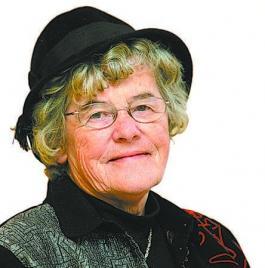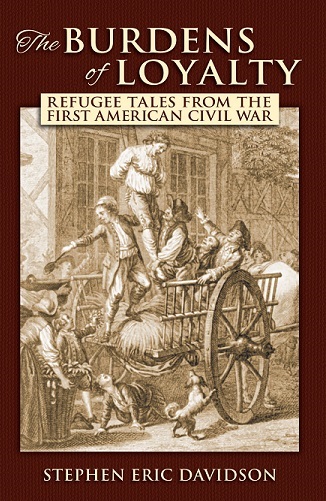
Ruby M. Cusack
"The Burdens of Loyalty" by Stephen Davidson
Monday was wash day to hang the clothes on the line but since this Saturday was a bright sunny day for December, with a breeze blowing and Gram said her joints felt like rain and snow coming, Aunt Sadie decided it would be a good day to hang the feather pillows out to air.
Gram quite agreed with her and they stripped many pillows down to the feather ticking.
The ladies did some other pre-Christmas cleaning and preparation and more or less forgot about the pillows on the line until Gramp came in and asked, ”Do you need a pot of hot tar?”
He went on to say the seams on at least five of the pillows had broken open while blowing in the wind that had come up and the ground under the line was covered with feathers.
Aunt Sadie called for Cliff and me to help her pick up the feathers and put them in flour bags. She warned us to only pick up the clean ones.
I asked Cliff how would hot tar help get this mess cleaned up. He just shrugged his shoulders.
Loyalist children knew very well the meaning of tarred and feathered as more than once a father, uncle or brother was smeared with hot tar and then covered in goose feathers.
John Melchoir File, a Loyalist wrote, ”You must try to walk in our shoes in order to understand the effect persecution had on our lives. Oil did gradually take off the tar and feathers from the skin of victims but the psychological effect of this cruel treatment lasted a lifetime.”
The psychological impact of being a loyalist is just one of many themes that historian Stephen Davidson explores in his book, The Burdens of Loyalty: Refugee Tales of the First American Civil War. The book follows the experiences of John and Hepzibeth Lyon, two loyalist refugees from Redding, Connecticut. Their experiences are an eerie foreshadowing of the trials of refugees in the 21st century. Like today’s Syrian refugees, the Lyons had to flee persecution in their hometown and find sanctuary in a British-sponsored refugee camp. They left Long Island in 1783 on an evacuation ship for a destination far from the American Revolution, and became the founders of a settlement where Connecticut accents were heard for years — Kingston, New Brunswick. 40,000 refugees flooded into what are now Nova Scotia and New Brunswick following the American Revolution. The Burdens of Loyalty puts a spotlight on 110-plus stories of those refugees who rubbed shoulders with the Lyon family — those who lived in Redding, who were refugee camp neighbours, who sailed together, and who pioneered together.
Here is a sampling of the refugee stories that the reader will discover in “The Burdens of Loyalty”.
David Pickett had been a prosperous weaver in Stamford, operating a shop that contained three looms. Until the revolution, his neighbours had considered him a good, honest man. However, when Pickett signed a paper that professed his continued allegiance to Britain, the revolutionary committee of Stamford tried him, labeling him an "enemy to his country". He was blackballed by his neighbours and forced to leave. Isaac Bell, another loyalist in the community, came to the aid of Mrs. Pickett and her seven children by offering them shelter and food. Pickett’s life illustrates that the Revolution was actually the first American Civil War with neighbour pitted against neighbour.
Tom Hyde, a Black Loyalist who sailed on the same evacuation ship as the Lyon family, had his name appear in the Book of Negroes. Two years later, Hyde’s name was among that of twelve free Africans who petitioned the New Brunswick government for land near the loyalist town of Kingston. Upon arriving in the colony, Black Loyalist refugees immediately began to exercise their rights as free Englishmen.
Saint John has had a vibrant Jewish community throughout its two hundred thirty-year history. David and Catherine Gabel were among the first of their faith to settle in New Brunswick, as refugees. At fifty years of age, Gabel left New York City to find yet another new home because of his loyalist convictions. On their ship’s manifest the couple and their four children were listed as “German Hebrews”. When brick buildings eventually replaced the log cabins of Saint John’s early settlement, the Gabels built a two-story bakery and butcher shop on the corner of Sydney and King Street North, just above King Square. When this building was demolished in 1956, the Jewish baker’s oven was still standing.
Walter Bates, a farmer and a teacher, was also a regular participant in guerrilla raids on coastal Connecticut towns across the Sound from Lloyd’s Neck throughout the course of the revolution. He was one of the original settlers of Kingston, and he married a Union passenger’s daughter, Abigail Lyon; theirs was the first wedding in the village. They lived the rest of their lives in the community they had helped to carve out of the wilderness. A former guerrilla fighter during the revolution, Bates eventually became the High Sheriff of Kings County.
Four years after his arrival in New Brunswick, John Lyon travelled to Saint John to present himself to the board of British commissioners at the compensation hearings. Lyon’s recounting of the burdens that he bore because of his loyalty are just one of many compensation claims cited in Davidson’s book. The loyalists’ situations before the revolution, the services they rendered to their king, and their settlement in the northern wilderness are all to be found in the records of the commission.
The Slocum family of Rhode Island carried many burdens for being staunch loyalists. Ebenezer Slocum supplied information and provisions to Lord Hugh Percy. The family was banished 16 kilometres inland so as not to signal British ships. Sarah Slocum was branded on the cheeks and had her ears cropped for allegedly passing bad currency.
As the story goes, the Reverend John Beardsley had lost two wives by the time he arrived in New Brunswick. In 1792, his third wife left him to return to New York. He had been led to believe his third wife died so he married the Widow Mary Quain. Then it was discovered his third wife was alive, forcing the bishop to launch an investigation into the matter of the bigamous clergyman.
John and Hepzibeth Lyon came to New Brunswick on the Union, the first evacuation vessel to bring loyalists to what is now New Brunswick. It is the Mayflower of New Brunswick’s loyalist history. The annotated passenger list that Davidson includes in The Burdens of Loyalty could almost be considered a book in itself as it holds so much information that would interest family historians and genealogists alike.
The Burdens of Loyalty can be ordered from UELAC - NB Branch, PO Box 484, Saint John, NB, E2L 3Z8. It is available on line at http://www.uelac-nb.ca/shop.htm.
|
New and Used Genealogical and Historical books of New Brunswick for sale. |
Back to Home of rubycusack dot com

